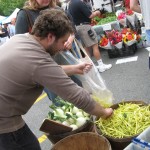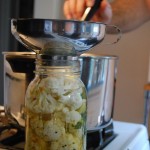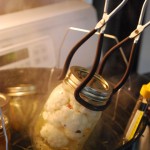Starter Pickles
This time of year always reminds me of summer days at my grandma’s house in Texas. Her garden produced lots of summer vegetables, but I distinctly remember the white enamel tubs full of green beans ready to be canned.
Being a renter in Seattle, I have not had a garden for a few years, but each summer I make several batches of homemade pickles out of the best of summer farmers market produce. I usually repeat a few favorite recipes each year from my book Pickled: Preserving a World of Tastes and Traditions, but there is one vinegar brine recipe that I particularly like because it provides a flexible base for a variety of vegetables of my choosing, and for experimenting with herbs and spices. I have used the same brine for jalapeno pepper rings, green beans, onions, and mixed vegetable pickles (like the recipe below). For over ten years, I have taught pickling classes to many first timers. It can be daunting but almost fail proof if you keep things simple the first time.
I recently invited friends Dan and Amber over for a pickling day at my house. They had never canned pickles before but were eager to learn. Unfortunately, our current rental has a tiny kitchen with little counter space but I wanted to show how adhering to a few basics can result in great tasting pickles for starters. A huge, modern kitchen is not required. There are plenty of good resources out there for learning about the world of canning, but if you are a pickle fan, following these few steps will get you started.
Choose a Simple Recipe
• Focus on one to three main vegetable ingredients
• Use a simple brine (I like one using equal parts white vinegar and water) and salt
• Play around with your favorite herbs and spices as you fill each jar
Choose and Prepare Ingredients
The idea is to preserve the freshest, seasonal produce from your garden or farmers market. All raw ingredients should be inspected, peeled and scrubbed clean at the beginning.
Gather Your Equipment
• Pint-sized Mason jars with screw caps and lids (Ball or Kerr)
• Water bath canner or large stock pot with lid (for processing)
• Stainless steel saucepan (for boiling the brine)
• Rubberized jar tongs (for lifting hot jars)
• Wide mouth jar funnel (for packing jars)
• Chef’s knife or other trusted knife
• Magnetic lid lifter
• Vegetable peeler
• Cutting board
• Clean kitchen towels
• Stainless steel or glass bowls (for storing prepared ingredients before packing)
• Measuring cups and spoons
• Bubble freer (non-metallic) or clean chopstick (for removing air bubbles)
• Apron
• Candy thermometer (to check water temperature)
• Food scale (to weigh ingredients)
Buying and Cleaning Jars
For first timers, I recommend using pint sized Mason-style jars with screw bands and vacuum seal lids. Kerr and Ball jars are the most common brands available at hardware stores and supermarkets. Buy them by the case if you have storage space in your home. Regular-sized screw bands and caps fit both sized jars, unless you prefer wide mouth jars. Make sure your jars and caps are in perfect condition. Check for cracks on your glass jars and avoid using bent metal screw bands.
Modern dishwashers won’t sanitize jars but will clean them just fine. If you are really concerned, you should boil your jars and screw bands before using. Do not boil caps, but ladle boiled water over the caps in a separate bowl to sanitize and soften rubber seals.
Water Bath Canner
I own a blue enameled metal water bath canner with a removable wire basket that fits inside to hold six pint or quart jars. Canners are available online or in hardware stores. If you do not have a water bath canner, you can build one by placing a clean, raised rack in a large stockpot. Jars can become too hot and crack if they have direct contact with bottom of the pot but they can be without the rack, depending on your heat source.
Use a submersible thermometer (like a candy thermometer) to check water temperature often. The temperature should read between 180 F and 200 F. As the filled jars are submerged into the canner, the water will cool temporarily to as low as 165 F, but then rise again.
Safe Handling and Processing
Fill your clean, warm jars carefully with vegetables and spices being careful to keep the jar mouth clean. Repeat until each jar is tightly packed but not higher than the jars shoulders. Contents will loosen up once the hot liquid is applied. Place the wide mouth funnel on the mouth the jar and ladle hot brine carefully into each jar allowing ¼ inch space at the top (the cap should rest easily on the mouth of the jar).

Insert a bubble freer (I use a chop stick) to break up any pockets between vegetables. Once your jars are filled, wipe the mouth clean. Remove the lid and cap in hot water bath with clean metal tongs and place it over the mouth of the jar so it rests centered on the lid. Screw the band down, but not so tightly that exhaust cannot escape during processing. Add the jar into the canning basket resting above the hot water that has by now reached at least 180 F. Once the basket is lowered, the water should clear the jars by 1-2 inches. Set the kitchen timer for 10 minutes and wait.
 Once processed for ten minutes, lift each jar carefully with rubber tongs and rest it on dry towel or a cooling rack. As the jar cools, the pressure inside the jar will pull the cap down in the center like a vacuum. You may hear a pinging sound as the seal is formed and the cap no longer gives to the touch. After about 6-12 hours your jars will be cool and the screw bands can be removed.
Once processed for ten minutes, lift each jar carefully with rubber tongs and rest it on dry towel or a cooling rack. As the jar cools, the pressure inside the jar will pull the cap down in the center like a vacuum. You may hear a pinging sound as the seal is formed and the cap no longer gives to the touch. After about 6-12 hours your jars will be cool and the screw bands can be removed.
CAA Contributor Lucy Norris is the author of Pickled: Preserving a World of Tastes and Traditions, a book that emerged from a three-year oral history project with the New York Food Museum. She is co-leader of the Slow Food Seattle chapter.
Photographs by Amber Zoe McMillan
Comments (0)
0